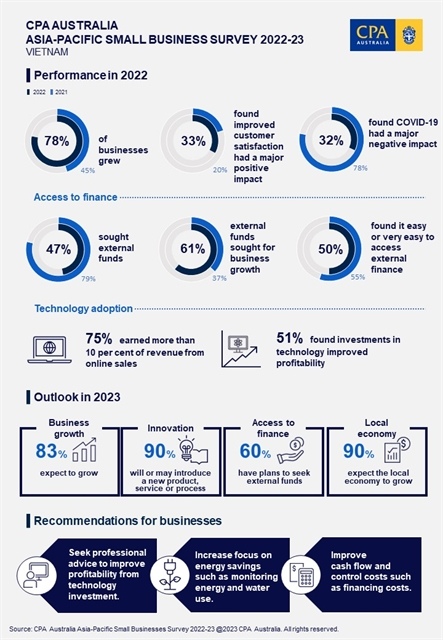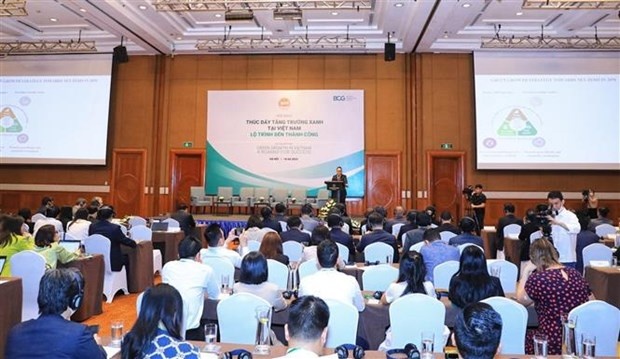Digitalisation and innovation spur Vietnamese small businesses on expansion
Digitalisation and innovation spur Vietnamese small businesses on expansion
Vietnamese small business owners overwhelmingly expect to grow in 2023, with a new survey showing they are the most confident in their local economy across the surveyed markets in the Asia-Pacific.

A photo shows key findings of CPA Australia’s latest Asia-Pacific Small Business Survey. — Photo courtesy of the company |
CPA Australia’s latest Asia-Pacific Small Business Survey shows Vietnamese small businesses’ swift recovery from the COVID-19 pandemic helped pave the way for growth last year. This momentum is expected to continue, with 83 per cent of Vietnamese respondents expecting their business to grow.
Nine out of 10 small businesses surveyed in Viet Nam also expect the local economy to grow in 2023. This was the strongest result of the 11 markets surveyed. Viet Nam also topped the list for small businesses growth in 2022 (78 per cent).
The COVID-19 pandemic was the most detrimental factor for Vietnamese small businesses last year but its impact had lessened. Fewer than one-third (32 per cent) reported that COVID-19 negatively impacted their business in 2022. This is down from 78 per cent in 2021.
“The Government’s support to small businesses to overcome COVID-19 has enabled them to rebound rapidly,” said Can Van Luc, Chair of CPA Australia’s North Vietnam Advisory Committee.
“Viet Nam reopened its borders in the first quarter of 2022, boosting foreign investment, international trade and tourism. The country’s digital economy boomed as businesses moved more online in response to COVID-19. This has significantly contributed to solidifying Viet Nam’s economic development."
The country’s institutional reforms and implementation of free trade agreements might further boost confidence, Luc said.
Financing demand has eased in Viet Nam last year. Half of the respondents found accessing external finance easy, but their need to borrow also dropped. Forty-seven per cent sought external funds last year, decreasing sharply from 79 per cent in 2021. Six-in-10 have plans to seek external funds this year.
“The majority of small businesses relied on banks for finance last year. Soaring interest rates are impacting small businesses’ intentions to seek external finance. It’s a sign that small businesses are increasingly cautious about financing costs. Tightening financial conditions across international markets also impact the appetite to borrow,” Luc said.
According to the survey, e-commerce maintained steady growth last year, with 75 per cent saying that they received more than 10 per cent of revenue from online sales.
However, the percentage of businesses reporting that their technology investment was profitable slumped to 51 per cent in 2022, from 82 per cent in 2021. Their focus on innovation remains strong with nine-in-10 having plans to introduce new products or services this year.
Of the 11 markets surveyed, Viet Nam had the highest percentage of small business owners aged between 30 to 49. Nine-in-10 small businesses had been established for less than 11 years.
“This is an interesting characteristic of Vietnamese small businesses. It implies that Vietnamese small business owners are likely more digitally sophisticated than their peers in the region. They are not only tech-savvy and embrace innovation, but also have solid working experience to expand their businesses, Luc noted.
He added a booming economy and an increase in foreign investment into Viet Nam may be prompting mature employees at management level to launch businesses. Their experience may help ensure a higher success rate.
Small businesses have experienced strong growth in digital transformation and technology adoption over the past three years driven by the pandemic. However, they should seek advice from professional advisers to improve the profitability of their technology investments, Luc suggested.
CPA Australia is one of the largest professional accounting bodies in the world, with more than 170,000 members in over 100 countries and regions, including more than 21,000 members in Southeast Asia.






















